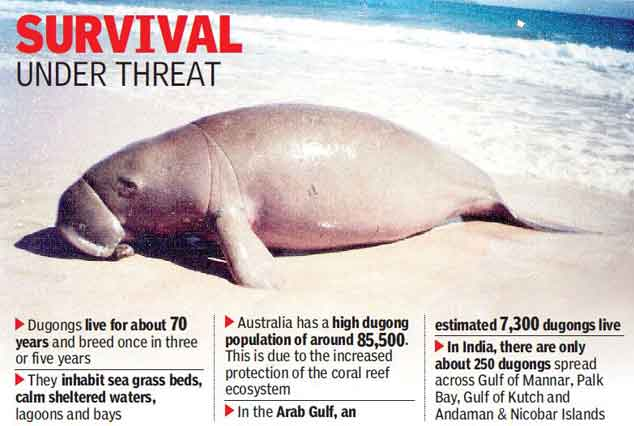Dugongs in Danger: Protecting India’s Sea Cows
Dugongs in Danger: Protecting India’s Sea Cows
Why in the News ?
May 28 is observed as World Dugong Day to raise awareness about the vulnerable dugong population in India. Despite their importance in maintaining marine ecosystems, only around 200 dugongs remain in Indian waters due to habitat loss and human activities, leading to significant population decline. The dugong conservation efforts in India have become increasingly crucial to protect these unique marine mammals.
Ecological Role and Habitat:
- Dugongs (Dugong dugon) are herbivorous marine mammals, often called “sea cows”, found in shallow coastal waters and seagrass habitats. The dugong in India plays a vital role in maintaining the health of marine ecosystems. Unlike some animals that live both on land and water, dugongs are fully aquatic mammals.
- They feed on seagrass species like Cymodocea, Halophila, Thalassia, and Halodule, consuming 20–30 kg/day of seagrass biomass.
- Dugongs play a vital role in maintaining healthy seagrass ecosystems, which stabilize seafloors, support biodiversity, and capture carbon.
- Dugong dugon is mainly found in the Andaman & Nicobar Islands, Gulf of Mannar, Palk Bay, and Gulf of Kutch. The Andaman and Nicobar Islands culture has long recognized the importance of dugongs in their marine ecosystem. The food of Andaman and Nicobar Islands often includes seafood, but dugongs are protected and not consumed. Tourists visiting these islands can enjoy Andaman beach photos showcasing the pristine coastal habitats where dugongs thrive.
Threats and Conservation Challenges
- Dugongs are listed as vulnerable (IUCN) and regionally endangered in India. The dugong IUCN status in India highlights the urgent need for conservation efforts.
- Only around 200 individuals remain in dugong habitats across India, threatened by:
○ Seagrass loss due to pollution, coastal development, and fishing.
○ Boat collisions, accidental entanglement in fishing nets, and illegal hunting.
○ Slow reproduction: Maturity at 9–10 years; calf every 3–5 years.
- Impact of climate change, port activities, and low public awareness also critical for dugong conservation.
Conservation Initiatives:
- Palk Bay Dugong Conservation Reserve (448.3 sq. km) launched in 2022 as part of the dugong conservation action plan.
- Need for mapping and restoring seagrass habitats and promoting sustainable fishing to protect dugong habitat.
- Encourage community engagement, eco-tourism, and citizen science in marine mammal conservation efforts.
- Use of tagging, drones, and traditional knowledge for long-term monitoring of Dugong dugon populations.
- The Indian Navy, Indian Coast Guard, and Marine Police are involved in dugong conservation efforts, including rescue operations and aerial surveys of seagrass ecosystems.
- Implementation of capacity building programs and awareness programs for local communities in dugong habitats, particularly in the Gulf of Mannar and Andaman and Nicobar Islands.
- Establishment of marine protected areas in key dugong habitats like the Gulf of Mannar and Andaman and Nicobar Islands to safeguard seagrass habitats.
- Launch of the Dugong Scholarship Programme to promote research and conservation efforts for dugongs in India.
- Creation of the Friends of Dugong network to engage local stakeholders in participatory conservation of Dugong dugon.
- Initiation of the CAMPA-Dugong Recovery Project for species recovery and habitat monitoring, including seagrass biomass assessment.
- Conducting regular underwater surveys and genetic assessments to track dugong sightings and population trends in Indian waters.
- Addressing the issue of incidental entanglement in fishing gear through stakeholder consultations and improved fishing practices to protect dugongs.
- Collaboration with organizations like the India Habitat Centre to host photo exhibitions and awareness events. India habitat centre photos featuring dugongs and their habitats can help educate the public about these unique marine mammals.
- Promoting the use of energy saving devices in coastal communities to reduce the environmental impact on seagrass habitats.
- Developing a fish logo design incorporating dugong imagery to raise awareness about marine conservation.
- Comparing dugong conservation efforts with initiatives in some of the safest cities to live in India to highlight the importance of creating secure habitats for both humans and marine life.
- Utilizing platforms like Colours Tamil Live to broadcast dugong sightings and conservation updates, engaging a wider audience in protection efforts.
About Dugongs – Key Facts |
| ● Species: Dugongs (Dugong dugon) are the only herbivorous marine mammals in India. |
| ● Appearance: Nicknamed sea cows, they resemble a mix of seals and whales. |
| ● Distribution: Found in Indo-Pacific waters, especially near Andaman & Nicobar Islands, Gulf of Mannar, Palk Bay, and Gulf of Kutch. |
| ● Habitat: Depend on shallow seagrass meadows (e.g., Cymodocea, Halophila, Thalassia, Halodule). |
| ● Longevity: Live up to 70 years. |
| ● Reproduction: Mature at 9–10 years, calve every 3–5 years; growth rate ~5% annually. |
| ● Conservation Status: |
| ○ IUCN: Vulnerable |
| ○ CITES: Appendix I |
| ○ Wildlife Act (India): Schedule I |
| ● Threats: Habitat loss, seagrass degradation, fishing gear entanglement, pollution, and climate change. |




